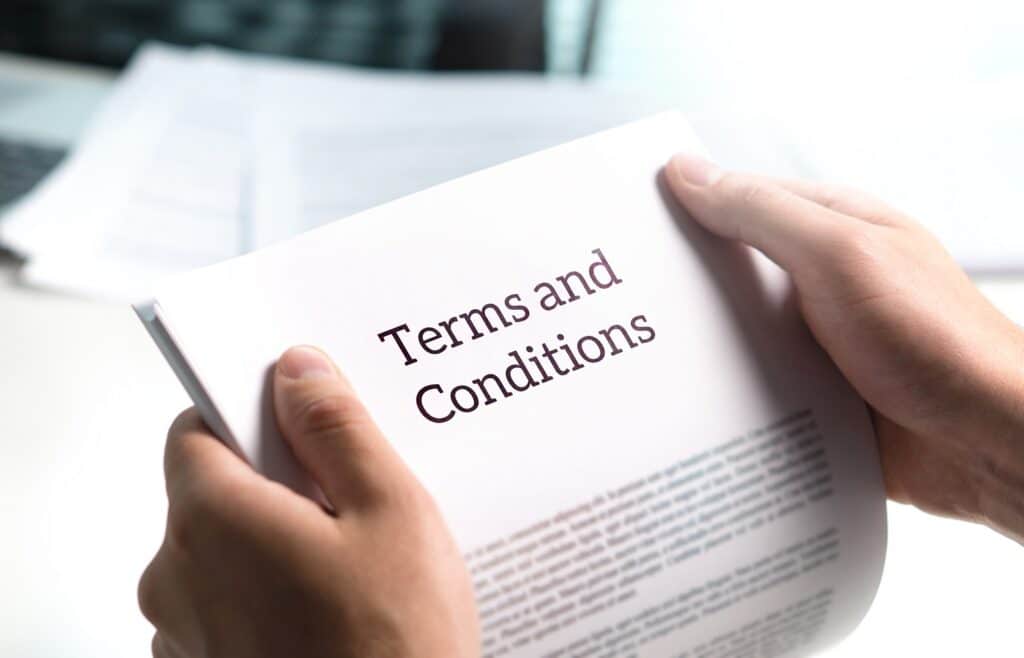An Attorney Explains How to Create Terms of Use for Web Services and More (Part 1)

So-called web services and other services on the Internet generally have what is known as “Terms of Use”. The content of these “Terms of Use” greatly influences the resolution of disputes between the service provider and the user, and even in similar cases, the conclusion may vary significantly depending on the content of the “Terms of Use”. In this article, we will explain how to create Terms of Use and points to note when creating them, while introducing sample clauses.
What are Terms of Use?
The “Terms of Use” refer to the set of rules compiled in writing by service providers, such as web services and games, for their users. These terms are created for various businesses, but they are often developed for internet-based services such as social networking sites (SNS), cloud services, and various download services. The content of the terms of use is determined by the service provider, and by agreeing to these terms and using the service, the terms of use become the contractual content between the service provider and the user. Furthermore, the terms of use can serve as a reference document for courts to make judgments in the event of a lawsuit. Therefore, it is essential to create comprehensive terms of use.
Correct Method of Creating Terms of Use

When creating terms of use, even if you refer to templates and the like, it is common for each service to have its own uniqueness. Therefore, it is personalityistic that a large part must be created based on the services provided by your company. However, regardless of the type of service provided, we will explain certain content that should be included. In this article, we will explain about agreement to the terms of use, account management, and prohibited actions, and the remaining parts will be explained in the following articles.
Agreement to Terms of Use
(Use of Service)
Article X
Registered users agree that by logging into their account as a registered user of this service, they effectively agree to the terms of use, and acknowledge that a usage contract, based on these terms of use, is established between our company and the registered user.
In order to actually apply the created terms of use, it is necessary to obtain agreement from each user to whom the terms of use apply. This is clearly stated. The methods of obtaining agreement include “clicking the agree button” or “checking the checkbox”, which are simpler methods compared to exchanging a contract. However, it is important to understand that compared to the method of signing and sealing a contract by both parties, the method of completing a contract with just a click is less reliable.
Therefore, it is necessary to design the site in such a way that it can argue and counteract any problems that may arise, by giving as much weight as possible to the act of “clicking”, such as making it impossible to press the agree button without displaying the full text of the terms of use.
Method of Changing the Terms of Use
(Changes to these Terms and Conditions)
Article X
1. We reserve the right to freely change or discontinue the content of this service.
2. We reserve the right to change these Terms and Conditions (including the rules and regulations related to this service posted on our website. The same applies hereinafter in this paragraph.). If we change these Terms and Conditions, we will notify registered users of the changes. After notifying the changes, if a registered user uses this service or does not cancel their registration within the period specified by us, the registered user is deemed to have agreed to the changes to these Terms and Conditions.
Even after obtaining agreement to the Terms of Use, we have stipulated the method of changing the Terms of Use in case the content of the service changes due to our circumstances. Since the Terms of Use are the conditions of the contract, it is a principle that consent must be obtained from the user each time the conditions are changed. However, many web services change the Terms of Use without obtaining explicit consent from users, stipulating in the Terms of Use that “the web service provider has the right to unilaterally change the Terms of Use”, as many users are indifferent to changes in the Terms of Use and there are few complaints unless the conditions significantly deteriorate.
However, when making changes to conditions that have a significant impact on users or that are disadvantageous, at the very least, you should stipulate responses such as notifying the content of the changes and “considering the continued use of the service after the change date as agreement to the changes”.
Definitions
(Definitions)
Article X
1. “Registered User” refers to an individual or corporation that has registered as a member of this service in accordance with Article 3.
2. “Paid Plan” refers to a plan, such as the “Pro Plan” of this service (including the plan after any changes to its name or content for any reason), that Registered Users can use by paying a fee.
3. “Paid Registered User” refers to a Registered User who has registered for the Paid Plan of this service in accordance with Article 7 and maintains such registration.
4. “Unregistered User” refers to an individual or corporation that uses this service without registering as a user in accordance with Article 3.
…(omitted)…
Terms of use are prepared in anticipation of potential disputes. Therefore, it is necessary to ensure that the content is clear not only to users and businesses, but also to third parties such as courts.
Therefore, for terms that are uniquely used in the provision of your company’s services, it is necessary to establish provisions on “definition of terms” to ensure that the content of the terms of use can be clearly understood even by third parties such as courts who are not familiar with your company’s services. In terms of format, arranging and explaining the terms in alphabetical order will improve the readability of the main text of the terms of use.
Account Registration and Management
(User Registration)
Article X
…(preceding text omitted)…
4. Our company, in accordance with our standards, will determine the eligibility of registration applicants. If we approve the registration, we will notify the applicant. Upon this notification, the registration of the applicant as a registered user is considered complete.
5. Upon completion of the registration as stipulated in the previous clause, a contract for the use of this service in accordance with the provisions of these terms and conditions is established between the registered user and our company.
6. Our company may refuse registration if the person who applied for registration under paragraph 1 of this Article falls under any of the following:
(1) If our company determines there is a risk of violation of these terms and conditions
(2) If there is any false, incorrect, or omitted information in all or part of the registration information provided to our company
(3) If the person has previously had their registration for this service or the use of this service cancelled
(4) If the person is a minor, an adult ward, a person under curatorship, or a person under assistance, and has not obtained the consent of their legal representative, guardian, curator, or assistant
(5) If our company determines that the person is or has been a member of antisocial forces, or is involved in the maintenance, operation, or management of antisocial forces through funding or other means
…(text omitted)…
(8) If our company determines that registration is inappropriate for any other reason
7. Our company may verify the identity of registered users and the truthfulness of their registration information at any time. Registered users must provide the necessary information for such verification in writing or other forms upon our request.
This provision lists exclusionary reasons to prevent potential future troubles that may arise from allowing the use of the service.
Clause 6(3) is a provision set up in anticipation of cases where users who have caused problems in the past attempt to re-register by obtaining a different account.
Clause 6(4) is a provision set up in anticipation of cases where the cancellation of a minor, etc. under the Civil Code is permitted. With the spread of mobile phones and smartphones among young people, there has been an increase in cases where minors make high-cost purchases in fields such as social games without the consent of their guardians, leading to disputes between guardians and operators. The Civil Code stipulates that if a minor enters into a contract without the consent of their guardian (accurately, “legal representative”), the contract can be cancelled at any time. Therefore, it is clearly stated that “if the consent of the guardian has not been obtained, the contract may be cancelled in the future, so registration will not be accepted in the first place”. However, even if this is stipulated as a reason for refusing registration, it does not mean that you do not have to confirm whether the consent of the guardian has been obtained. If you neglect to confirm and accept an application from a minor who has not obtained the consent of their guardian, it will be difficult to prevent the cancellation by the minor with this provision alone, so caution is required.
Clause 6(5) is a provision set up in consideration of ordinances such as those of local governments to exclude organized crime groups. It is a recent trend to include a clause in contracts and treaties stating that relationships with antisocial forces will be severed, which is also required in transactions with listed companies.
Clause 6(8) is a provision set up to cover gaps, as it is impossible to specifically list all cases where registration should be refused.
(Password and Registration Information Management)
Article X
1. Registered users are responsible for managing and storing their passwords and registered email addresses. They must not allow third parties to use them, nor lend, transfer, change the name of, sell, or trade them.
2. Registered users are responsible for any damage caused by inadequate management of passwords or registered email addresses, errors in use, or use by third parties. Our company assumes no responsibility for such damage.
3. If a registered user discovers that their password or registered email address has been stolen or used by a third party, they must immediately notify our company and follow our instructions.
Users often think they can freely use and dispose of their accounts. However, if there is a system of charging for each account, sharing accounts can lead to a decrease in sales. Also, sharing or transferring accounts can potentially cause security problems. In services where users create accounts, there may be situations where the registered account is taken over by a third party. Therefore, we stipulate that sharing and transferring accounts is prohibited, and that users are responsible for managing their accounts. We also clearly state that any accidents caused by violations of these rules are the responsibility of the user.

Prohibited Actions
(Prohibited Actions)
Article X
1. Users must not engage in any of the following actions in connection with the use of this service:
(1) Actions that infringe on the intellectual property rights, portrait rights, privacy rights, reputation, or other rights or interests of our company, other users of this service, external SNS operators, or any other third parties (including actions that directly or indirectly cause such infringement).
(2) Actions related to criminal activities or actions contrary to public order and morals
(3) Actions of sending obscene information or information harmful to minors
(4) Actions of sending information related to dating
…(omitted)…
(18) Other actions that our company deems inappropriate
2. If our company determines that the actions of a registered user in this service fall under any of the items in the preceding paragraph, or there is a risk of such, we may take the measures based on the following items without prior notice to the registered user. Our company shall not be liable for any damages incurred by the registered user due to the measures taken by our company based on this paragraph.
(1) Request to stop the violation
(2) Deletion of the content that is the subject of the violation, and cessation of the violation
(3) Suspension of the use of this service
(4) Other measures that our company deems necessary
(5) Public announcement of the measures taken in the manner deemed appropriate by our company
On apps and web services, there will always be a certain number of users who engage in nuisance or harmful behavior. If no provisions have been prepared in advance to prohibit such nuisance behavior, it becomes practically difficult to stop it. Therefore, it is necessary to list actions that are inconvenient for the business operator as “prohibited actions” in the terms of use in advance.
Many web services generate revenue by providing the same service to many users. Therefore, how efficiently the business operator can control the unexpected behavior of undesirable users is a very important factor directly linked to the sustainability of the service. Therefore, prohibited actions can be said to be one of the most important provisions in practice among the various conditions stipulated in the terms of use. By listing as comprehensively and specifically as possible the prohibitions unique to the actual service provided, in addition to general matters such as infringement of other companies’ rights and prohibition of criminal acts, it becomes easier to take measures such as account suspension due to violation of prohibitions.
For example, when receiving a protest that the penalty for violating a prohibition is unfair, if the behavior in violation clearly falls under the prohibited actions, simply conveying this often easily resolves the claim. In this sense, it is very useful in practice to describe prohibited actions in a detailed and foolproof manner. However, it is difficult in reality to list all prohibited actions at the release stage, so it is realistic and important to review the prohibitions as problems arise through the operation of the service.
The second paragraph stipulates penalties and the like for prohibited actions. Even if prohibited actions are stipulated, if there is no penalty for them, they will not serve as a deterrent to nuisance behavior. In the above provision, the contents stipulate step-by-step measures such as requests for cessation of nuisance behavior, injunctions, and suspension of use.
Summary
Terms of use are also contracts, and as such, it is essential that there is a consensus between the parties involved. The key to creating appropriate terms of use lies in how well the process leading to the formation of an agreement is handled. This can also help avoid unnecessary conflicts with users. In the second part, we will discuss penalties for actions that violate prohibited behaviors, as well as compensation for damages.
The second part can be found here.
Category: IT
Tag: ITTerms of Use





















